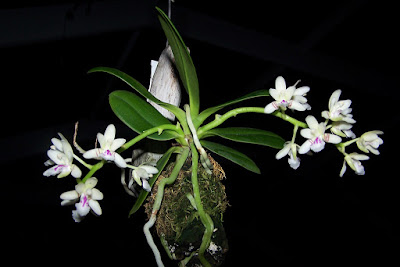Sedirea japonica is native to Japan and Korea. This orchid is supposedly found from the Ryukyu Islands and south to the Iriomote Island...
Sedirea japonica also called as The Japan Sedirea, Phalaenopsis japonica, Aerides japonica, Angraecum japonicum, Hygrochilus japonica, is a species of the genus Sedirea. This species was described by Leslie Andrew Garay & Herman Royden Sweet in 1974.
IDENTIFY SEDIREA JAPONICA
Sedirea japonica is native to Japan and Korea. This orchid is supposedly found from the Ryukyu Islands and south to the Iriomote Island.
It is a small sized, cool to cold growing species with a monopodial, very short stem carrying 5 to 8, narrowly elliptic to strap shaped, obtuse at the obscurely bilobed apex, 6 cm in length and about 2.5 cm in width leaves.
The Japan Sedirea flowers in the spring and summer from the 18 cm long inflorescence carrying 6 to 10 flowers open in succession and are prized for their sweet fragrance. The flowers are up to 3 cm in diameter and form a kind of cup, because the concave ridge petal bends forward over the prone, and the slightly concave petals of the inner whorl advance forward so that their tips are on both sides of the spine and are almost parallel to it. They are loosely arranged in each bunch. The petals of both whorls are pale-yellowish-greenish, and the lower half of the outer flakes of the outer whorl have several narrow, transverse, reddish-purple lines of irregular shape. The white lip is differently marked with bright, irregular, pinkish-purple or scarlet spots. The spine is white with a small amount of pink purple on the underside near the apex.
SEDIREA JAPONICA CARE AND CULTURE
Cultural information should only be used as a guide, and should be to be adapted to suit you. Your physical location; where you grow your plants, how much time you have to devote to their care, and many other factors, will need to be taken into account. Only then can you decide on the cultural methods that best suit you and your plants.
Light:
Sedirea japonica needs a light level of 18000-25000 lux. The plants should never be exposed to the direct rays of the midday sun. Strong air movement should be ensured all the time.
Temperature:
It is a thermophilic plant that requires a cold winter rest. In summer, the average day temperature is 26-31 ° C, at 19-23 ° C at night, with a daily amplitude of 7-8 ° C. The average temperature of the winter day is 12-13 ° C, the night 3-4 ° C, with a daily amplitude of 9 ° C.
Humidity:
The Japan Sedirea needs the humidity of 75-80% throughout the year.
Substrate, growing media and repotting:
Sedirea japonica can be grown in shallow containers with good drainage or on tree rootstocks. However, such plants require high humidity, and during hot and dry weather, they should be watered several times a day.
It can also be grown in small, shallow pots or baskets with a fast drying surface with excellent drainage and good aeration, containing moisture retaining components, but which allows quick drying after watering. Small plants until maturity are grown in 10 cm pots. Pine bark or chopped tree fern fibers mixed with pieces of pearlite or chopped sphagnum will be a loose substrate, however, retaining some moisture. The addition of charcoal helps to ensure permeability and prevents soda.
The plants should be repotted immediately when the substrate begins to decompose, or when growing out of pots. If repotting is done at the time when new roots begin to appear, the plant will be accepted and rooted in the shortest possible time.
Watering:
From spring to autumn, rainfall in the natural habitat is abundant, then passing into a slightly drier period lasting from late autumn throughout the winter. The cultivated plants should be watered abundantly during the period of intensive growth, but excellent drainage should be ensured so that the ground around the roots is never damp or soggy. When nighttime drops in the fall start in the autumn, the amount of water should be gradually reduced.
Fertilizer:
During the active growth, the plants should be fertilized every week 1/4-1/2 of the recommended dose of fertilizer for orchids. You can use of sustainable fertilizers throughout the year, but can also use fertilizer with an increased nitrogen content from spring to mid-summer, and then in late summer and autumn fertilizer containing an increased content of phosphorus.
Rest period:
Sedirea japonica live relatively shortly, usually blooming for no more than 4-5 seasons. It seems more likely that these plants need a cold period to enter the sleep phase giving the necessary rest. When the winter temperatures are too high, the plants just keep growing and eventually die of exhaustion. In winter, the plants need less water and they should dry well between watering, especially when they are grown in cold conditions. They will be less affected by exposure to low temperatures when dry. Fertilization should be eliminated until new growths appear and more watering begins in the spring.















COMMENTS